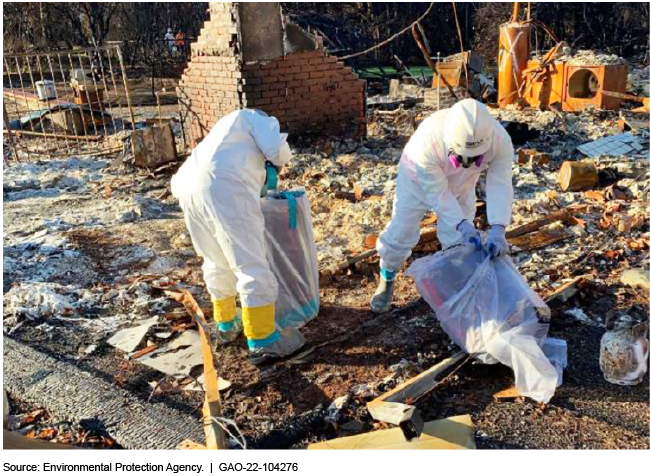Household Hazardous Waste Removal: EPA Should Develop a Formal Lessons Learned Process for Its Disaster Response
Fast Facts
The Environmental Protection Agency coordinates federal efforts to remove household hazardous waste (e.g., asbestos, paint, and pesticides) requiring special handling and disposal from wildfire-affected properties.
Following its 2018 and 2020 California wildfire responses, EPA collected staff feedback to identify what worked well and areas for improvement. We found additional ways EPA could improve its efforts to learn from its disaster responses, including tracking corrective actions in a formal, centralized way.
We recommended that EPA develop a formal "lessons learned" process that includes key practices, like tracking corrective actions.
Members of an EPA Task Force removing material that is suspected to contain asbestos from a property affected by a wildfire in California

Highlights
What GAO Found
To remove household hazardous waste—some items that can catch fire, react, or explode under certain circumstances or that are corrosive or toxic—after the 2018 and 2020 California wildfires, the Environmental Protection Agency (EPA) took steps that followed its emergency response policy. For example, EPA led coordination efforts between federal, state, and local agencies and established incident management teams. These teams developed plans for assessment, removal, transportation, and disposal of the waste. EPA removed waste from three counties in 2018 and seven counties in 2020. See figure below.
Examples of Household Hazardous Waste Removed by the Environmental Protection Agency after the 2018 and 2020 California Wildfires

Following its wildfire responses, EPA conducted lessons learned activities, such as gathering feedback from staff to identify lessons and developing corrective actions. Lessons learned provide a method to share good ideas for improving work processes, quality, and cost-effectiveness. Key practices of a lessons learned process include collecting and sharing information on positive and negative experiences and developing and tracking corrective actions.
However, GAO identified additional lessons learned activities that may have been useful. For example, GAO found that EPA does not track corrective actions in a formal, centralized way, and EPA has not implemented all of the needed corrective actions. After the 2018 wildfires, for example, EPA found that it needed to develop a proposal to increase the number of EPA On-Scene Coordinators responsible for overseeing disaster responses, but the agency did not do so.
EPA conducts lessons learned activities on a case-by-case basis and does not have a formal lessons learned process in place for wildfire or other disaster responses that specifies when and what lessons learned activities should be conducted. The National Response Framework—which describes how the federal government, states, and others should respond to disasters and emergencies—states that planning for disaster response should include a feedback loop, including through lessons learned processes. Developing a formal lessons learned process that includes key practices, such as tracking corrective actions, will help EPA be better prepared to respond to future disasters, including those that involve removing household hazardous waste.
Why GAO Did This Study
In 2018 and 2020, California experienced record-setting fire seasons, resulting in the damage to or destruction of over 20,000 structures. EPA plays a significant role in responding to some wildfires and coordinates federal efforts to assist with the removal of household hazardous waste. Following a fire, EPA recommends special handling and disposal for these products, particularly if their containers are compromised.
The Additional Supplemental Appropriations for Disaster Relief Act, 2019, includes a provision for GAO to review a range of response and recovery issues following the 2018 disaster season. This report examines (1) the steps EPA took to remove household hazardous waste after the 2018 and 2020 wildfires in California and (2) the extent to which EPA conducted lessons learned activities following its wildfire responses. GAO reviewed relevant agency documents related to household hazardous waste removal after wildfires and applied criteria for planning lessons learned activities. GAO interviewed representatives from federal agencies, as well as state and local officials involved in the response to the 2018 and 2020 wildfires.
Recommendations
GAO is making one recommendation for EPA to develop a formal lessons learned process with written guidelines for its disaster response that incorporates key practices. EPA agrees with the recommendation.
Recommendations for Executive Action
| Agency Affected Sort descending | Recommendation | Status |
|---|---|---|
| Environmental Protection Agency | The Director of the Office of Emergency Management at EPA should develop a formal lessons learned process with written guidelines for disaster responses, including responses to Stafford Act disasters, that incorporates the key practices of a lessons learned process. |
Closed – Implemented
In December 2022, the Director of the Office of Emergency Management distributed lesson learned guidelines to all EPA regions for use after disaster responses. These guidelines provide a consistent process for tracking, implementing, sharing, and verifying lessons learned for Stafford Act disaster responses.
|
